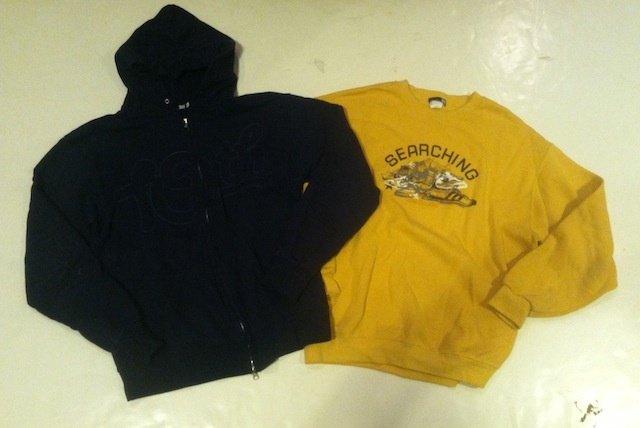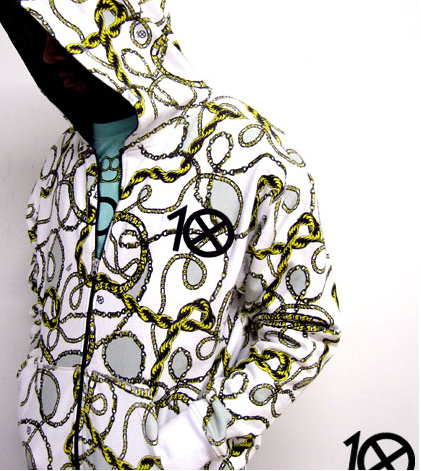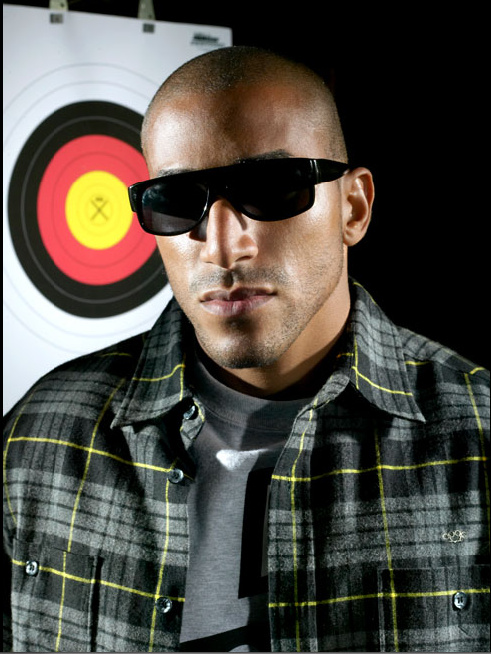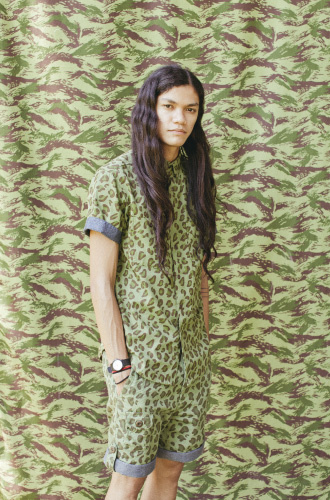![]()
Last week was the 30th anniversary of Sundance, America's most famous independent film festival. It was started by Robert Redford back in 1978 and has played most of the best films of the past three decades. The whole experience of Sundance is weird, because the festival takes over this small ski town in Utah called Park City. In fact, the best time to ski in Park City is during Sundance, because no one is on the slopes. Instead, everybody is walking around the main street gawking at celebrities drinking coffee and bundling up... I spent a week at this year's festival, cooped inside of dark theaters searching the screens for something worthwhile to write about. I was at the movies so often, it took me five days to actually meet the people I was crashing with during the festival. They came home from a party late one night and shook me awake, whispering loudly at my face, "Who are you?" I told them I was reviewing movies for VICE and they asked me if I knew where the bathroom was. Then I told them I was in bed, asleep. That really stumped them.
Anyways, I've reviewed some of the movies I saw at Sundance below. Some of these films have celebrities, some do not. Some are going to get a wide release—but some are so awful, you better hope they never come to a theater near you.
THE OVERNIGHTERS
![]()
![]()
America has always been a land of second chances—especially to those who can pay for it: presidents, bankers, R. Kelly, etc... Jesse Moss’s documentary investigates this phenomenon in a small, bible-belting town in North Dakota after fracking became big business. While most of the country’s economy is still struggling, this town has tripled in size and keeps dishing out six-figure jobs in the oil fields. That population boom includes second chancers from all over—people with nothing else to do and nowhere else to go. There are thieves, abusers, and sex offenders. When the local pastor starts practicing the bible’s edict of "love thy neighbor" and allows the felons a free place to crash overnight, the other neighbors practice their right to be dicks. The more the pastor tries to do good, the more the film reveals evil. Nothing is better than hypocrites getting their comeuppance. This shit has loads to spare.
A MOST WANTED MAN
![]()
![]()
Billed as the thinking man’s spy thriller, I couldn’t help but think everything was really fucking obvious. From the moment they introduce any character, they lay it all out for you. It’s pretty hard to watch a spy movie when there’s no mystery about who’s guilty, who's getting screwed over, who’s playing who, and what’s going to happen. All that’s left you to do is watch Philip Seymour Hoffman look dangerously diabetic, Rachel McAdams be a one-dimensional "cute girl," Willem Dafoe not be a good Willem Dafoe, and all three of them speak in crappy German accents. Anton Corbijn, your films used to be cool.
WHIPLASH
![]()
![]()
I hate it when the premise of a movie nearly destroys the film itself. In Damien Chazelle's second feature, Whiplash, a young student wants to become one of best jazz drummers ever, which is kind of weird considering this film takes place today and not 80 years ago. These days, most people want to rap or make music with knobs and switches. The student's teacher is a hard ass and makes him cry until he’s good, which sounds like pretty lame entertainment. However, on the silver screen, the film is as tense as a great jazz song. The thing two-steps, waltzes, and punches. It sweats, has a breakdown, and then crescendos. The teacher, J. K. Simmons, is as brutal as the drill sergeant from Full Metal Jacket and, even though he’s really close, Miles Teller doesn’t pull a Private Pyle. The feature was adapted from the director’s Grand Jury Prize winning short last year and is just as big a crowd-pleaser.
GOD HELP THE GIRL
![]()
![]()
God get me out of here is the only thing anyone will think when they watch the Belle & Sebastian singer Stuart Murdoch's directorial debut. It’s a movie about a girl with undefined emotions surrounding her vaguely defined anorexia and it is told through song. With the help of her trusty, trust fund girlfriend and the dopiest of mediocre songwriting wannabes, they set out on pretty fucking lame adventures—going to the park, rowing canoes, swimming, going to concerts, etc... These are the moments the girl couldn’t experience before? I mean, the girl is played by the beautiful Emily Browning and—minus her urban outsider outfits—she isn’t shown to have any real problems in life. This is just another High School Musical, but with a European cast and school happens to be out for summer. Stick to music, Stuart, but make it like you used to—like when it was good.
JAMIE MARKS IS DEAD
![]()
![]()
This film made me wish I was dead. There was nothing remotely interesting about this bullshit attempt at a brooding gay ghost film. It follows a kid named Cam, who regrets not having been nicer to Jamie Marks, a loser at school who recently died and may or may not have been murdered. The ghost of Jamie can transport Cam anywhere in the world via dark closets, so at one point in the film they go and stay in the barn of a psychotic murderer... Then there's Cam’s mom, who gets hit by her best friend in a car accident. His mom becomes paralyzed, but it doesn’t actually impact the overal film except that her drunk friend who hit her hangs out at their house, a fact that also has no impact on anything. Are you following any of this? I couldn't. Not one of the arcs in this movie sticks. The story is kind of ambiguous, but the narrative is so all over the place, it just couldn't pull it off.
KUMIKO THE TREASURE HUNTER
![]()
![]()
This was one of my favorite films at the festival. It is based on the fantastic true story of a Japanese woman becoming disenchanted with her dull life in Tokyo and absolutely enchanted by the Coen Brother’s film Fargo, specifically the scene where a bloodied Steve Buscemi buries a briefcase of cash on the side of a Minnesota highway. After stealing her boss’s credit card, the meek Kumiko takes off on a journey to the United States with just the clothes on her back, her homemade maps, and—of course—a DVD copy of Fargo. Filled with offbeat humor, beautiful cinematography, and a psychedelic score, this is one you have to see.
APPROPRIATE BEHAVIOR
![]()
![]()
If one was to replace Lena Dunham’s character on Girls with a bi-sexual Iranian woman, but keep the hipster humor and nudity, you would have Appropriate Behavior. While that sounds like a legit recipe for vomit, it’s much sweeter and funnier than mouth excrement. I know it’s an unfair statement to compare every modern young female-centric movie to Girls because guys have been doing the same stories since we could talk, but this is really fucking similar. That said, the writer/actor/director doesn’t just rehash a story of a disenchanted New York youth, but pulls off a fresh coming-of-age in America, as she embraces modernity versus tradition.
FRANK
![]()
![]()
If a movie starring the Oscar-nominated Michael Fassbender wearing an oversized papier-mâché head for 95 percent of a movie while performing in a super weird neo-punk band alongside Maggie Gyllenhaal, Domhnall Gleeson, and Scoot McNairy sounds amazing then we're on the same page. Imagine my surprise when all of the fun, irreverence, and creativity of it is zapped out of it once the head is removed and everything is chalked up to mental illness and mediocrity. Even more troubling is that most of the movie is enjoyable. It’s essentially a catalyst for absurd little jokes and peculiar moments, but when added up it’s just a funny looking piece of shit. Poised as the path artists take to find themselves and as an expression of outsider art, the resolution proves it’s the antithesis of its goal: Art isn’t recognized for its quality, but instead, championed for it’s novelty and viral ability. Like how every review of Frank says it’s good or bad because they do or don’t like the weirdness of Michael Fassbender in a mask the entire time, not what the movie’s actually about.
BOYHOOD
![]()
![]()
Filmed over the span of 12 years, Richard Linklater’s new film is nothing short of a modern masterpiece of minutiae. The years see the growth of a six-year-old boy through primary school and ends as he enters college. Filming three or four days every year, the team—including Ethan Hawke as his semi-deadbeat dad, Patricia Arquette as the hard-working, Alcoholic-marrying mother, and Lorelei Linklater (the director’s own daughter) as his older sister—literally age and grow in front of our eyes. If you’ve ever had parents, had a sibling, or grew up (or didn’t) there’s something in this movie for you. The film grew with the actors and the world simultaneously and incidentally, now serves as one of the most accurate period pieces of the 2000s. Music, gadgets, fashion, and the news are used as cultural signifiers, the density of which will be more appreciated from multiple viewings. The cumulative results of the film are remarkable and hard to ignore—you get to witness a boy become a man and you don't have to knock anyone up.
THE SIGNAL
![]()
![]()
What starts out as a tense mystery about three computer hackers and their failing love life’s turns into the The Matrix Reloaded, with Laurence Fishburne reprising his monotone messiah role. This time, we think it’s aliens instead of technology, but little Laurence has got the same stuff up his sleeve in this film. It starts off like The Matrix, following the rabbit, but halfway through it becomes the sequels and veers mainstream with big explosions and silly CGI, before tripping over its ideas again and again (which is funny because the main character’s legs don’t work and he falls a lot, too). This is the type of movie that will please some genre bros, but it is too arty to play mainstream and too mainstream to play arty.
LIFE ITSELF
![]()
![]()
I grew up watching Roger Ebert on Siskel & Ebert. I knew his name and face before most celebrities. I mean, “Two Thumbs Up.” Although he was easily the most famous film critic of the last two decades, I really only knew that he won a Pulitzer, was on TV, married a black chick, and had his jaw removed because of thyroid cancer. Life Itself is a thorough, funny, and heartbreaking documentary by Steve James (Hoop Dreams) that gives you an inside look into Roger's life. The film is beautifully rendered with interviews of his peers and loved ones along with great archival footage, viscous arguments with Gene Siskel, and awesome candid stories about Ebert getting sloshed at bars with hookers. The film turned the man into a legend. I mean, Ebert, the lovable film critic was a vitriolic, alcoholic slut for a lot of his life before he cleaned up—and when he did in the movie, I cried tears for him.
OBVIOUS CHILD
![]()
![]()
If this movie proves anything, it’s that you can’t go wrong with an abortion joke, especially if you’re the funny and very talented Jenny Slate. She stars as the immature and accidentally knocked up mama-to-be, whose life is falling apart faster than she can say a fart joke. The film is a lot of things you’d expect from a modern female comedy, but when they break taboos and upset the status quo, it’s much more tasteful and sensitive than dudes crossing swords. This is a perfect icebreaker film for all you first-daters out there that feel the need to be honest about your past and talk about the time you went gay, took two at once, or Plan B’d your B.
WHITE BIRD IN A BLIZZARD
![]()
![]()
I thought we were done with over-the-top suburban melodramas after Douglas Sirk perfected them in the 60s, but here is Gregg Araki trying to do it again, this time with a gay twist (because he’s gay). Oh wait, Douglas Sirk already did that twist when Rock Hudson, star of All That Heaven Allows, came out as one of Hollywood’s most prominent homosexuals. Regardless, this movie is supposed to be about female teen angst, so there’s plenty of nudity, bitchiness, and very obvious, cliched poetic metaphors about feelings. The film is like watching an angry, mentally-challenged family play Clue with all of the mystery cards face up, yelling at each other that they can’t read the words that look like “gay,” “murder,” “basement,” and “obvious.”
CAPTIVATED: THE TRIAL OF PAMELA SMART
![]()
![]()
I went into this film thinking it was going to be boring. If you don’t remember, Pamela Smart was on trial in the 90s for allegedly colluding with her 15-year-old lover Billy Flynn and three of his friends to murder her husband. The trial was the first ever to be publicly broadcast and it had all of the elements news outlets love: a pretty woman turning an innocent seeming boy bad, adultery, conspiracy, and murder. The story has already been made into two movies, one starring Nicole Kidman and the other with Helen Hunt. But similar to Errol Morris’s crime documentary, The Thin Blue Line, Captivated convincingly shows how the media and this perfect cocktail of a story influenced the public’s—and therefore the jury’s—decision to convict Pamela to a life sentence without the chance of parole. What results is a fascinating and haunting mediation on America’s flawed justice system, the solidifcation of gossip into fact through media, and how people can convince themselves of anything to survive.
NO NO: THE DOCKUMENTARY
![]()
![]()
Dock Ellis is one of the most fascinating and controversial baseball players to ever step onto the field. The dude is such a badass that he actually pitched a no-hitter against the San Diego Padres in 1970 while under the influence of LSD, amphetamines, and other stimulants. This documentary tries to show that he’s more than a crazy, outspoken druggie—he's a crazy, outspoken druggie of moral, upstanding qualities regarding the role of black athletes and drug rehabilitation. But he also beat his ex-wife. With this movie, they’re basically saying he’s complicated. The film is fine, but for someone as amazing as Dock, this should’ve been more amazing. I’ll prove it with two videos: the no-hitter and him reading a letter from Jackie Robinson. There, now you know Dock. Dock rocks. I saved you 90 minutes.
PING PONG SUMMER
![]()
![]()
The best and maybe the only throwback film at Sundance. Ping Pong Summer recreates the nostalgia of the East Coast 80s like nobody’s business. Wind breaking pants, fly names, big ol’ boom boxes, arcade video games, and family vacations in the station wagon. This coming-of-age-but-in-the-past picture stars one Radical Miracle, a hopelessly dorky teen who’s out to do it all: get the girl, beat the jerk, make a friend, and have a good time doing it. The film’s plot moves like that of its ancestors, but it successfully mines all of the humor, awkwardness, in-jokes, and references. With everything thrown in, it tastes like Rad’s favorite drink, a “suicide,” which is a dash of every soda in the soft drink line. The film—like the drink—is cool, but it’s not the best in the soda fountain.
BEST ONLINE SHORT: RAT PACK RAT
![]()
Mad genius Todd Rohal's Rat Pack Rat is the winner of a Special Jury Prize for Unique Vision. The film is incredibly bizarre and could change your opinion of Sammy Davis Jr. and the song "Candy Man." I don't want to spoil it. Just watch it before Monday morning, when it gets taken down.














































.jpg)












































